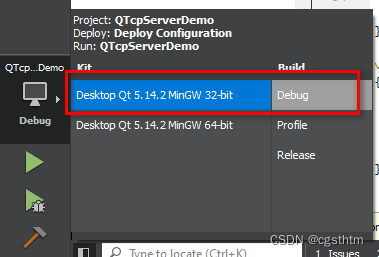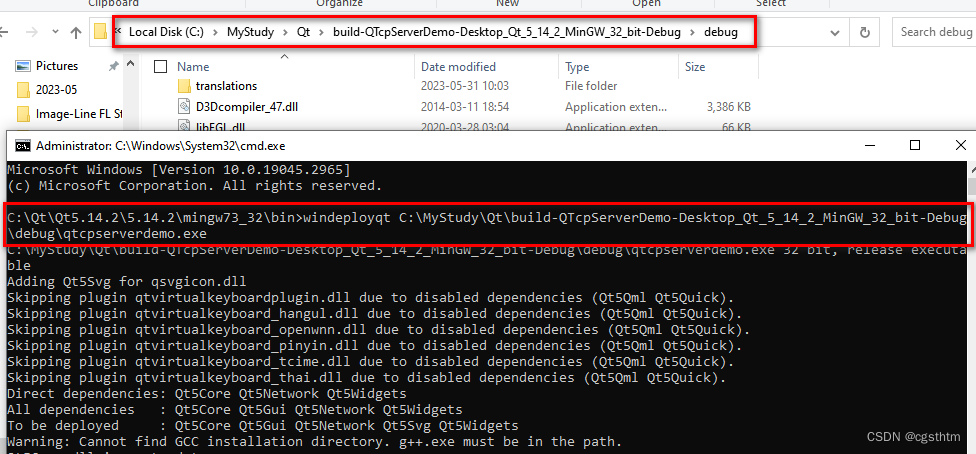您现在的位置是:首页 >学无止境 >Qt下QTcpServer服务端识别多个QTcpSocket客户端网站首页学无止境
Qt下QTcpServer服务端识别多个QTcpSocket客户端
简介Qt下QTcpServer服务端识别多个QTcpSocket客户端
文章目录
Qt官方文档
QTcpSocket Class :https://doc.qt.io/qt-5/qtcpsocket.html
QAbstractSocket Class:https://doc.qt.io/qt-5/qabstractsocket.html
QTcpServer Class:https://doc.qt.io/qt-5/qtcpserver.html
编写QTcpServerDemo和QTcpSocketDemo
看一下效果先:

实现QTcpServerDemo
头文件:
#ifndef MAINWINDOW_H
#define MAINWINDOW_H
#include <QMainWindow>
#include <QTcpServer>
#include <QTcpSocket>
#include <QNetworkConfigurationManager>
#include <QNetworkInterface>
QT_BEGIN_NAMESPACE
namespace Ui { class MainWindow; }
QT_END_NAMESPACE
class MainWindow : public QMainWindow
{
Q_OBJECT
public:
MainWindow(QWidget *parent = nullptr);
~MainWindow();
public slots:
/// 服务端接收到客户端连接的槽函数
void TcpServerConnected();
/// 服务端接收客户端发送的数据的槽函数
void ReadAllData();
/// 客户端连接断开的槽函数
void ClientDisconnected();
private slots:
/// 点击启动按钮
void on_btnRun_clicked();
private:
Ui::MainWindow *ui;
/// QTcpServer是服务端
QTcpServer *tcpServer = nullptr;
/// QTcpSocket是服务端程序用来与客户端进行通信的
QTcpSocket *tcpSocket = nullptr;
/// 用来存储来自客户端的连接
QList<QTcpSocket*> tcpSocketList;
};
#endif // MAINWINDOW_H
源文件:
#include "mainwindow.h"
#include "ui_mainwindow.h"
#include <QDebug>
MainWindow::MainWindow(QWidget *parent)
: QMainWindow(parent)
, ui(new Ui::MainWindow)
{
ui->setupUi(this);
tcpServer = new QTcpServer(this); // 构造函数中实例化tcpServer
connect(tcpServer,&QTcpServer::newConnection,this,&MainWindow::TcpServerConnected); // 当有客户端连接到服务端就执行TcpServerConnected槽函数
}
MainWindow::~MainWindow()
{
delete ui;
for(auto client : tcpSocketList)
client->close();
}
/// 点击启动按钮
void MainWindow::on_btnRun_clicked()
{
QHostAddress address = QHostAddress("127.0.0.1"); // ip
int port = 5023; // 端口
if(tcpServer->isListening()) // 判断服务端是否开启了监听
{
tcpServer->close()
for(auto client : tcpSocketList)
client->close();
tcpSocketList.clear();
ui->label->setText(QString("关闭监听成功,%1:%2").arg(address.toString()).arg(port));
ui->btnRun->setText("开启");
}
else
{
if(!tcpServer->listen(address,port)) // 服务端开启监听
ui->label->setText(QString("开启监听失败,%1:%2").arg(address.toString()).arg(port));
else
{
ui->label->setText(QString("开启监听成功,%1:%2").arg(address.toString()).arg(port));
ui->btnRun->setText("关闭");
}
}
}
/// 当有客户端连接到服务端
void MainWindow::TcpServerConnected()
{
tcpSocket = tcpServer->nextPendingConnection();
if(!tcpSocketList.contains(tcpSocket))
tcpSocketList.append(tcpSocket);
connect(tcpSocket,&QTcpSocket::readyRead,this,&MainWindow::ReadAllData);
connect(tcpSocket,&QTcpSocket::disconnected,this,&MainWindow::ClientDisconnected);
ui->txtLog->append(tcpSocket->localAddress().toString() + " 已连接");
}
/// 服务端接收客户端发送的数据
void MainWindow::ReadAllData()
{
QTcpSocket *client = dynamic_cast<QTcpSocket*>(sender());
QByteArray buff = client->readAll();
qDebug() << buff;
ui->txtLog->append(buff);
client->write(buff);
}
/// 当关闭与客户端的连接时
void MainWindow::ClientDisconnected()
{
QTcpSocket *client = dynamic_cast<QTcpSocket*>(sender());
QString msg = QString("触发断开连接,%1:%2").arg(client->peerAddress().toString()).arg(client->peerPort());
qDebug() << msg;
ui->txtLog->append(msg);
}
实现QTcpSocketDemo
头文件:
#ifndef MAINWINDOW_H
#define MAINWINDOW_H
#include <QMainWindow>
#include <QTcpSocket>
#include <QTcpServer>
#include <QNetworkInterface>
QT_BEGIN_NAMESPACE
namespace Ui { class MainWindow; }
QT_END_NAMESPACE
class MainWindow : public QMainWindow
{
Q_OBJECT
public:
MainWindow(QWidget *parent = nullptr);
~MainWindow();
public slots:
void ReadAllData();
void Connected();
void Disconnected();
private slots:
void on_btnSend_clicked();
void on_btnDisconnect_clicked();
private:
Ui::MainWindow *ui;
QTcpSocket *tcpSocket = nullptr;
QHostAddress address;
int port;
};
#endif // MAINWINDOW_H
源文件:
#include "mainwindow.h"
#include "ui_mainwindow.h"
#include <QDebug>
MainWindow::MainWindow(QWidget *parent)
: QMainWindow(parent)
, ui(new Ui::MainWindow)
{
ui->setupUi(this);
tcpSocket = new QTcpSocket(this);
connect(tcpSocket,&QTcpSocket::readyRead,this,&MainWindow::ReadAllData);
connect(tcpSocket,&QTcpSocket::connected,this,&MainWindow::Connected);
connect(tcpSocket,&QTcpSocket::disconnected,this,&MainWindow::Disconnected);
address = QHostAddress("127.0.0.1");
port = 5023;
ui->txtIp->setText(address.toString());
ui->txtPort->setText(QString::number(port));
}
MainWindow::~MainWindow()
{
delete ui;
}
void MainWindow::ReadAllData()
{
QByteArray buff = tcpSocket->readAll();
qDebug() << buff;
ui->txtLog->append(buff);
}
void MainWindow::Connected()
{
QString address = tcpSocket->peerAddress().toString();
int port = tcpSocket->peerPort();
qDebug() << QString("连接成功, %1:%2").arg(address).arg(port);
ui->txtLog->append(QString("连接成功, %1:%2").arg(address).arg(port));
}
void MainWindow::Disconnected()
{
ui->txtIp->setEnabled(true);
ui->txtPort->setEnabled(true);
ui->btnSend->setText("连接");
}
void MainWindow::on_btnSend_clicked()
{
QString txt = ui->txtSend->toPlainText();
tcpSocket->write(txt.toStdString().c_str());
}
void MainWindow::on_btnDisconnect_clicked()
{
address = QHostAddress(ui->txtIp->text());
port = ui->txtPort->text().toInt();
if(tcpSocket->state() == QTcpSocket::SocketState::ConnectedState)
{
ui->txtIp->setEnabled(true);
ui->txtPort->setEnabled(true);
tcpSocket->disconnectFromHost();
ui->btnDisconnect->setText("连接");
}
else
{
ui->txtIp->setEnabled(false);
ui->txtPort->setEnabled(false);
tcpSocket->connectToHost(address.toString(),port);
ui->btnDisconnect->setText("断开");
}
}
使用windeployqt生成程序运行所需依赖文件
确认编译环境:

在对应编译环境目录下运行 windeployqt 生成运行程序所需的依赖文件:

风语者!平时喜欢研究各种技术,目前在从事后端开发工作,热爱生活、热爱工作。






 U8W/U8W-Mini使用与常见问题解决
U8W/U8W-Mini使用与常见问题解决 分享几个国内免费的ChatGPT镜像网址(亲测有效)
分享几个国内免费的ChatGPT镜像网址(亲测有效) stm32使用HAL库配置串口中断收发数据(保姆级教程)
stm32使用HAL库配置串口中断收发数据(保姆级教程) QT多线程的5种用法,通过使用线程解决UI主界面的耗时操作代码,防止界面卡死。...
QT多线程的5种用法,通过使用线程解决UI主界面的耗时操作代码,防止界面卡死。... SpringSecurity实现前后端分离认证授权
SpringSecurity实现前后端分离认证授权